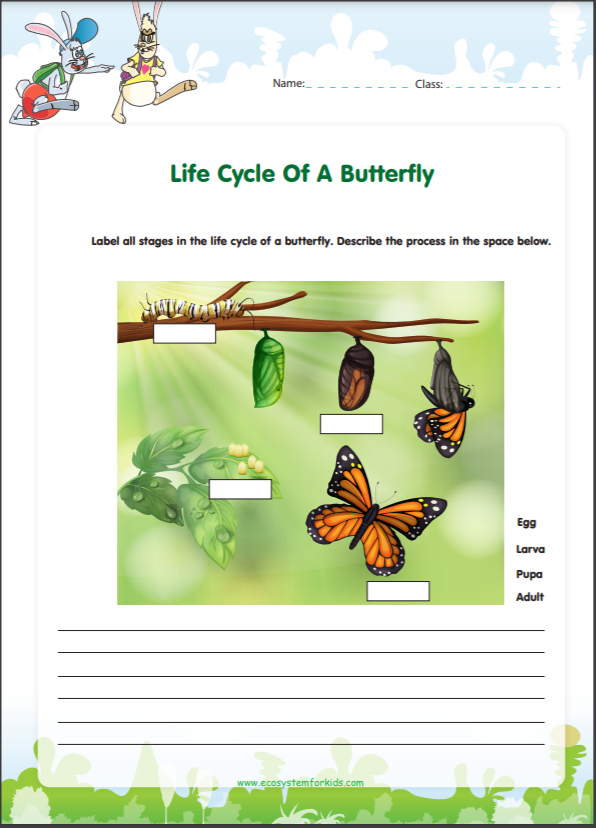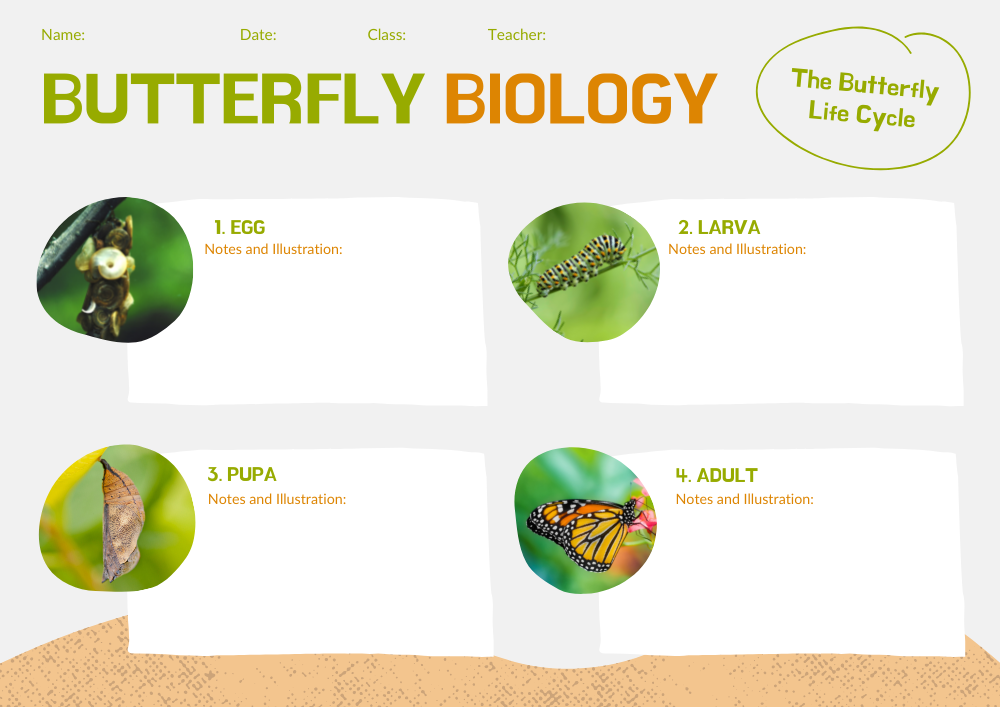The Life Cycle Of A Butterfly Online Game
Other Science Games For Kids
 Butterflies are very colorful insects which children love to play with. Depending on the species, some of them have very bright colored wings. This is partly why butterflies are great to watch when stored in insect collections. However, did you know that the earlier stages in the life cycle of a butterfly were not always as colorful? Children instead dread the scary caterpillars they find on trees. Reasonably so because some caterpillars have dangerous defense mechanisms which they carry as fur on their skin. These can be very harmful if they get in contact with the skin. However, adult butterflies are safe to play with. They love flowers and suck the sweet nectar out of them. That is what they eat. The life cycle of a butterfly has some quite interesting facts. Did you know that the larva (also caterpillar) is a herbivore, eating green grass by chewing with its mandibles while the adult rather uses its long suckers to suck nectar from flowers. This page contains an interactive online game on the stages in the butterfly’s life cycle. It replaces a worksheet on the topic and is convenient since players can make several attempts until they get to understand all the stages. A butterfly first lays eggs that mature into a caterpillar. The caterpillar to butterfly process may last between 5 to 21 days depending on the species. In this game, children will drag and drop the egg in stage one and the rest of the stages. It is an example of complete metamorphosis. The game is a science activity for 1st grade, 2nd grade, 3rd grade, 4th grade, 5th grade and 6th grade. In the UK system of education, this is equivalent to science for year 2, year 3, year 4, year 5, year 6, year 7 and year 8.
Butterflies are very colorful insects which children love to play with. Depending on the species, some of them have very bright colored wings. This is partly why butterflies are great to watch when stored in insect collections. However, did you know that the earlier stages in the life cycle of a butterfly were not always as colorful? Children instead dread the scary caterpillars they find on trees. Reasonably so because some caterpillars have dangerous defense mechanisms which they carry as fur on their skin. These can be very harmful if they get in contact with the skin. However, adult butterflies are safe to play with. They love flowers and suck the sweet nectar out of them. That is what they eat. The life cycle of a butterfly has some quite interesting facts. Did you know that the larva (also caterpillar) is a herbivore, eating green grass by chewing with its mandibles while the adult rather uses its long suckers to suck nectar from flowers. This page contains an interactive online game on the stages in the butterfly’s life cycle. It replaces a worksheet on the topic and is convenient since players can make several attempts until they get to understand all the stages. A butterfly first lays eggs that mature into a caterpillar. The caterpillar to butterfly process may last between 5 to 21 days depending on the species. In this game, children will drag and drop the egg in stage one and the rest of the stages. It is an example of complete metamorphosis. The game is a science activity for 1st grade, 2nd grade, 3rd grade, 4th grade, 5th grade and 6th grade. In the UK system of education, this is equivalent to science for year 2, year 3, year 4, year 5, year 6, year 7 and year 8.
Life cycle of a butterfly Lesson For Kids
Butterflies develop and grow through a process called metamorphosis. There are two types of metamorphosis: Complete and incomplete metamorphosis. Butterflies undergo a complete metamorphosis; meaning, they go through four main stages which we are: the egg, caterpillar (or larva), pupa and finally adult. This video will cover each stage in detail.
Let’s look at the first stage which is the egg. Eggs are laid on plants by a mature female butterfly. These eggs will later become food for the hatchlings which we are going to talk about next.
The second stage in the life cycle of a butterfly is the larva and occurs when the eggs hatch into caterpillars. A caterpillar eats green vegetation, grows in size and sheds its skin about 4 to 5 times during its existence. They are known to grow 100 times their initial size at this stage depending on the species.
The third stage is the pupa also called chrysalis. Unlike the previous stage, there is no feeding at this stage. The pupa sticks to a tree branch and stays in the same spot. However, major transformations take place within the cocoon that protects the pupa. Special cells within it start to grow and develop into legs, wings, eyes and other parts that are found in an adult butterfly.
The fourth and last stage is the adult butterfly. This is what we all see flying around and sucking nectar from plants. The adult has long legs, long antennae and large compound eyes. They are colorful and can fly over long distances. At maturity, adult butterflies are once again ready to lay eggs and start the cycle all over again.
I hope you enjoyed watching this video on the life cycle of a butterfly. Remember to subscribe to our channel for more videos like this.
Parts of a butterfly worksheet - Print
Check out this parts of a butterfly worksheet to test your knowledge of butterflies. We all love this insect because they are varied, colorful and of different species. Given that butterflies suck nectar as their food, they are usually found sucking juices off of flowers. Their beauty tends to blend into the beauty of flowers to give us this image of a very beautiful insect. People actually have a collection of butterfly species that they have dried up and stored in glass boxes. Some butterfly species have wings that span across several centimeters. Others are small; what makes them all peculiar is their mode of life and how they fly. Did you know that the earlier stage of a butterfly is something children are rather scared of. Butterflies were not always colorful; at their earlier stages called caterpillars, they were scary itchy organisms that children ran away from. A caterpillar also does not have the same diet as an adult butterfly since it mostly feeds on green leaves. It is infact a herbivore at this stage. After eating to a certain size and attaining a certain maturity, this organism goes into a dormant stage that later becomes an adult butterfly with all its splendor. Check out the parts of a butterfly worksheet herein and start learning about butterflies.
Butterfly Life Cycle Poster -Print !
What are the 4 stages of a butterfly life cycle ? You probably guessed it by now, egg, larva, pupa and adult. For teachers, this life cycle poster will serve as a great resource for the classroom. It will enable children to remember all the stages of this wheel of life. Print out this sheet in a large poster and paste it at a corner in the classroom and ask students to write out the stages and explain in their own words what they think these stages are. This poster in a smaller form can also be used as a worksheet. In this case, students can do the exercise as a homework and write notes on what each stage looks like. Teachers can grade each sheet and post up the best script in the class
.
You might have seen earlier that a caterpillar looks different from an actual butterfly. They walk and cannot fly since they do not have wings. They are herbivores and only eat green vegetation. They have well adapted chewing mechisms / mandibles that crush green grass into injestible pieces. This stage prepares the insect for a dormant stage where no food is eaten called the pupa.

Adult butterflies are colorfol and much fun to play with. They have a mouth that is suitable for sucking up nectar from flowers. They can fly and blend into the beauty of nature. Have you ever seen a collection of colorful butterflies? You will learn a lot about this insect from such collections.
Butterfly life cycle kids - Worksheets | Poster | Game Online | Have fun learning














